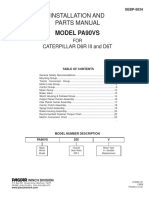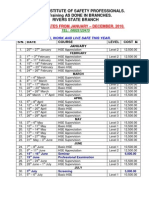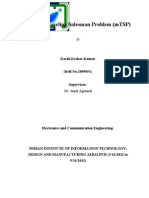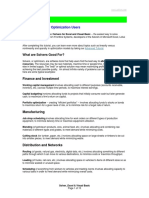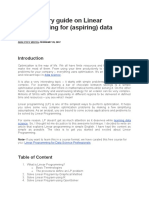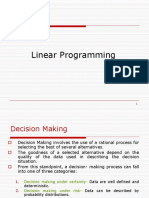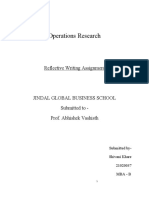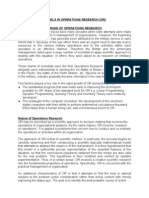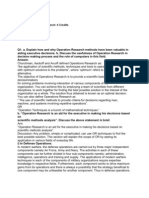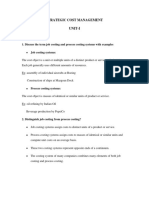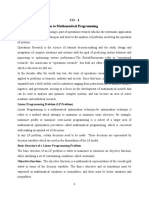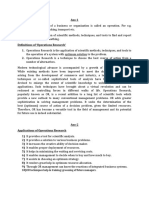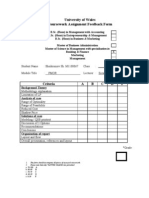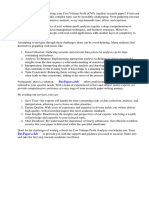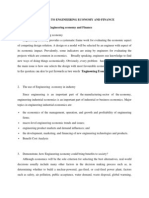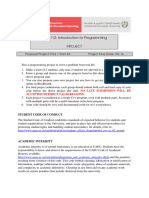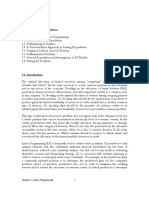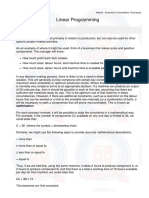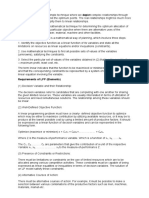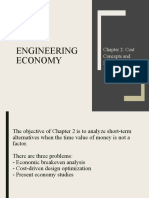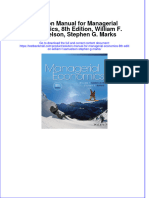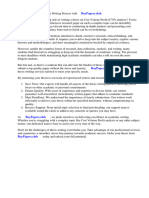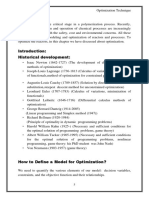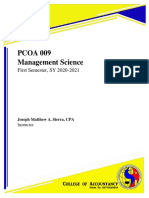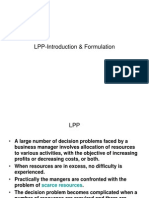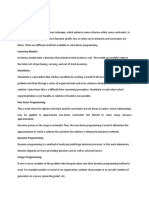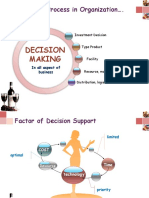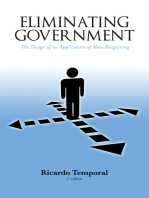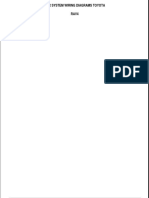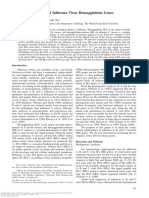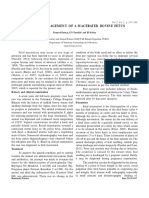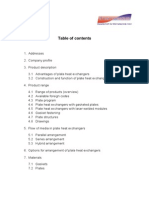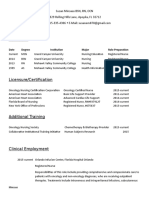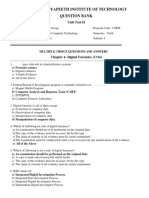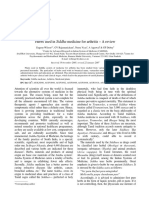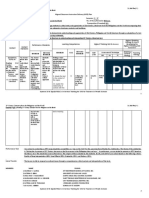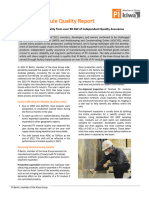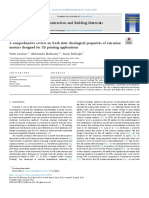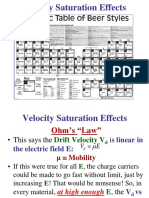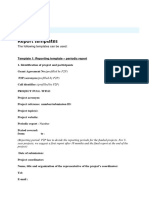Professional Documents
Culture Documents
Final Assignment Yann JACOBSEN Research Methods For Managers
Final Assignment Yann JACOBSEN Research Methods For Managers
Uploaded by
Taleb B PandaOriginal Description:
Original Title
Copyright
Available Formats
Share this document
Did you find this document useful?
Is this content inappropriate?
Report this DocumentCopyright:
Available Formats
Final Assignment Yann JACOBSEN Research Methods For Managers
Final Assignment Yann JACOBSEN Research Methods For Managers
Uploaded by
Taleb B PandaCopyright:
Available Formats
FinalAssignment
ResearchMethods
forManagers
YannJACOBSEN
International School of Management
ISEG Group 1A
Agenda
1. During the seminar we worked with the following cases:
a. Color chips
b. Computers S and L
c. Make or buy
d. Bike-lib
e. Scheduling personnel
f. Assigning planes
g. A case of public health
Describe briefly the main lessons that you got from each one of these cases.
2. Explain with several practical examples why sensitivity analyses (objective function
coefficients and RHS constraints) are so important.
3. Let`s suppose that two constraints have the Iollowing shadow prices:
Constraint A = 132.66
Constraint B = 79.02
Is it obvious that to increase the constraint A`s RHS is more interesting that to
increase the constraint`s B RHS?
4. With this final assignment you will find in Connect the slides that we used during the
seminar (Iile named 'RM slides Group 1A 2012). Slides 14 to 16 were not used in
class. In slide 15 you will find a network composed of nodes (circles in different
colors) and arcs (links between nodes). White figures associated to each link represent
the capacity of this link and red figures represent the cost of this link. Develop a LP
model in order to answer the question at the bottom of the slide: which is the maximal
quantity of flow that can reach the destination nodes (7 and 8) from the source nodes
(1, 2 and 3)?
5. Slide 16 shows the same network in slide 15 but now the destination nodes have a
given demand associated to these nodes (77 for node 7 and 82 for node 8).
Considering that the capacity and unit cost of each link are the same indicated in slide
15, develop a LP model in order to answer the question at the bottom of the slide:
which is the optimal distribution of flow (from source nodes via transhipment nodes
to destination nodes) to satisfy demand in destination nodes (7 and 8) minimizing
transportation costs.
6. ModiIy the problem oI 'A case in public health in order to know the minimal value
of the total fund in order to satisfy all proposed goals. Remember that several goals
should be expressed as percentages of the total fund you have to find. Explain very
clear your model and show the results you got.
All questions worth 10 points
Remember that this final assignment is strictly individual
1.
The main lessons that I`ve got Irom these diIIerent cases are
A: Color chips
In this case, chips we used permitted us to understand the way to maximize a production by
regarding resources. Furthermore, we discovered how to obtain the best profit according to
the way we use the resources.
On the other hand, the exercise permits us to discover that numerous possibilities exist in this
problem. Moreover, it has allowed us to understand that mathematical formulae make the
solution easier to find.
Accordingly, we noticed that there are many different numerous research methods which
permit to the manager to take the best decision.
B: Computers S and L
In this case, we had to find a way to organize the production of two different kinds of
computers with various components. It exists limitations we had to take in consideration,
which was the main difficulty.
So, this exercise showed us how we have to manage resources and also how we can manage
production which allows us to make the best choices in order to maximize the profit.
C: Make or buy
With this exercise, we had to discover if it was better to produce or to buy the product to
suppliers by taking in consideration the production costs of the product.
We had to decide how many sub-assemblies it should manufacture at home and also how
many it should buy abroad. The use of the solver permitted us to define the best profit for
each possibility.
D: Bike Lib
Here, the main idea is to arrive to minimize all the costs of bikes movement between a station
from another one. We had to develop an optimization tool in order to minimize reallocating
costs.
It allows us to understand how to optimize, in a company, the planning of tasks by a
diminution and minimizing the cost. We used to maximize the production to maximize the
profit.
E: Scheduling personnel
In this case, we were allowed to manage staff expenses. Moreover, we had to help the call
center proposing how many workers should participate in each schedule in order to minimize
the total costs.
So, we must minimize the cost of the payroll considering the timetable of the employees.
F: Assigning planes
Here, we had to propose an airplane assignment in order to minimize the number of
passengers that should change plane. So, we had to optimize a service which is offered by a
company. We must know how to spare time considering constraints.
G: A case of public health
Here, with our know-how in linear programming, we had to find an optimal allocation of
funds in order to meet the proposed goals. So, it`s a question oI scholarships` allocation
considering limitations. We must maximize the distribution to reduce constraints as better we
can.
2.
The sensitivity analysis is a method which consists in modifying variables, a way to predict
the outcome oI a decision. It`s a technique used within specific boundaries. It consists to
analyze changes to anticipate consequences of different modiIications. That`s why it`s very
important because in business, we can with this technique take the best decision we can in
order to maximize production and minimize costs.
We can now illustrate this method with a concrete example. A car company wants to
schedule a negotiation. In this way, the want to buy to the suppliers all resources needed to
manufacture cars that they want to sell in the market. They have to know the number of units
they want to produce with all the different elements of the car. This car company resolved
this problem knowing variables like quantities and also the all constraints which correspond
to the price or the discounts. Moreover, the company imagines a negotiation in order to
minimize costs and also to maximize quantity. The aim is to manufacture as much units they
can starting from their resources they negotiated forward.
3.
Shadow price is an opportunity cost of an activity to a society and also the value of a profit
which corresponds to the number of resources.
In this case, we have two constraints corresponding to A (132,66) and B (79,02). If the
shadow price of A is 132,66, that means that when we have an additional resource A, we are
going to obtain a better proIit than 132,66. It`s the same Ior B, that means that when we have
an additional resource B of 79,02, we are going to obtain a better profit than 79,02.
Nevertheless, shadow price doesn`t include and doesn`t consider the constraints. So, when we
consider diIIerent constraints, it`s easier to know and to arrive to a better profit. Moreover,
the solver and also the sensitivity are very important. We must on the one hand look the final
result but also to see how we can diversify this result taking into consideration the constraints
and variables affected.
4.
We have to develop a Linear Program in order to answer this question: which is the maximal
quantity of flow that can reach the destination nodes from the source nodes?
First of all, we must define a model with these decision variables:
- X1= the quantity of products that can travel from node 1 to node 4
- X2= the quantity of products that can travel from node 1 to node 5
- X3= the quantity of products that can travel from node 1 to node 7
- X4= the quantity of products that can travel from node 2 to node 4
- X5= the quantity of products that can travel from node 2 to node 5
- X6= the quantity of products that can travel from node 2 to node 6
- X7= the quantity of products that can travel from node 3 to node 5
- X8= the quantity of products that can travel from node 3 to node 6
- X9= the quantity of products that can travel from node 4 to node 5
- X10= the quantity of products that can travel from node 4 to node 7
- X11= the quantity of products that can travel from node 4 to node 8
- X12= the quantity of products that can travel from node 5 to node 4
- X13= the quantity of products that can travel from node 5 to node 6
- X14= the quantity of products that can travel from node 5 to node 7
- X15= the quantity of products that can travel from node 5 to node 8
- X16= the quantity of products that can travel from node 6 to node 7
- X17= the quantity of products that can travel from node 6 to node 8
In consequence, we can define the objective function which is:
Max (X1+X2+X3+X4+X5+X6+X7+X8+X9+X10+X11+X12+X13+X14+X15+X16+X17)
Now, I can define the constraints:
- Total quantity of products _ total capacities of flows (that can reach the
destination nodes)
- Decision variables _ 0
- Consider all products that can reach the transhipments nodes
- The last one have to be redistributed to reach the destination nodes
Now this is the Excel document:
Here we have two boards. The first one corresponds to the translation of the PowerPoint
slides. The second one corresponds to the translation of the equation solver. So we can now
solve the objective function which determines the maximal quantity of products that can
reach the destination nodes.
Furthermore, there are different colours in the boxes. The yellow ones represent the variables
cells we have to need to find out.
The blue ones are here to represent the maximal quantity that can reach the transhipments
nodes.
The salmon ones define the total quantity that can reach the destination nodes according to
the blue boxes.
Different formulas were used like:
- J12 = SOMME(B12:I12)
- E18 = SOMME(E12:E17)
- H18 = SOMME(H12:H17)
- J22 = the result we are trying to find out
- L22 = SOMMEPROD(B2:I7;B12:I17)
After the use of the solver, we can say that the maximal quantity of flow that can reach the
destination nodes from the source nodes is 182.
5.
The decision variables are the same as the fourth question:
- X1= the quantity of products that can travel from node 1 to node 4
- X2= the quantity of products that can travel from node 1 to node 5
- X3= the quantity of products that can travel from node 1 to node 7
- X4= the quantity of products that can travel from node 2 to node 4
- X5= the quantity of products that can travel from node 2 to node 5
- X6= the quantity of products that can travel from node 2 to node 6
- X7= the quantity of products that can travel from node 3 to node 5
- X8= the quantity of products that can travel from node 3 to node 6
- X9= the quantity of products that can travel from node 4 to node 5
- X10= the quantity of products that can travel from node 4 to node 7
- X11= the quantity of products that can travel from node 4 to node 8
- X12= the quantity of products that can travel from node 5 to node 4
- X13= the quantity of products that can travel from node 5 to node 6
- X14= the quantity of products that can travel from node 5 to node 7
- X15= the quantity of products that can travel from node 5 to node 8
- X16= the quantity of products that can travel from node 6 to node 7
- X17= the quantity of products that can travel from node 6 to node 8
The objective function is this one:
Min (X1*its cost+X2*its cost+X3*its cost+X4*its cost+X5*its cost+X6*its cost+X7*its
cost+X8*its cost+X9*its cost+X10*its cost+X11*its cost+X12*its cost+X13*its cost
+X14*its cost+X15*its cost+X16*its cost+X17*its cost)
Moreover, constraints are the same as the fourth question but there are two more. That means
the six constraints are:
- Total quantity oI products _ total capacities oI Ilows (that can reach the
destination nodes)
- Decision variables _ 0
- Consider all products that can reach the transhipments nodes
- The last one have to be redistributed to reach the destination nodes
- Maximal cost we can have to the destination 7 is 77
- Maximal cost we can have to the destination 8 is 82
In Excel, there are the costs (board which translates the constraints representing by costs
associated to each flow), the capacity (boards which translates the decision variables) and a
third board which translates the equation solver in order to solve the objective function.
The different formulas are:
- K13 =SOMME(C13:J13). It`s the same Iormula Ior the others lines (K14
=SOMME(C14;J14), .)
- F19 =SOMME(F13:F18); It`s the same formula for the others columns (F20
SOMME(G13;G18), .)
- K19 =SOMME(K13:K18)
- K26 =SOMMEPROD(C3:J8;C13:J18)
These next pictures correspond to the solver I made:
This is why I can say that the optimal flow
distribution to satisfy the demand
minimizing costs is 1434.
6.
Now we are going to modify the A problem. We have to find the minimal value of the total
fund in order to satisfy all proposed goals.
If we compare to the exercise from the public health, we can try to take into consideration the
money constraints and we can also try to minimize then objective function.
If we put it on Excel, we can say that the answer on the Excel document is:
These are the formulas:
- A17 =SOMMEPROD(A6:E6;$A$5:$E$5)
- A18 =SOMMEPROD(A7:E7;$A$5:$E$5)
- A19 =SOMMEPROD(A8:E8;$A$5:$E$5)
- A20 =SOMMEPROD(A9:E9;$A$5:$E$5)
- A21 =SOMMEPROD(A10:E10;$A$5:$E$5)
- A22 =SOMMEPROD(A11:E11;$A$5:$E$5)
- E16 =SOMME(A20:A22)
You might also like
- Installation and Parts Manual D6R - D6TDocument23 pagesInstallation and Parts Manual D6R - D6TJUAN CARLOS PAZ100% (3)
- NISP Safety Course ManualDocument16 pagesNISP Safety Course Manualrichancy100% (4)
- Master in Business Administration: Data AnalyticsDocument20 pagesMaster in Business Administration: Data AnalyticsSovan Dash100% (1)
- OR2 - Transportation Cost Optimization - Nawaf Alshaikh1Document7 pagesOR2 - Transportation Cost Optimization - Nawaf Alshaikh1Nawaf ALshaikhNo ratings yet
- Economic 2Document8 pagesEconomic 2Abdullah KhanNo ratings yet
- LPP Formulation and Graphical MethodDocument22 pagesLPP Formulation and Graphical MethodKarthik AC100% (2)
- Mail - Iiitdmj.ac - in Squirrelmail SRC Webmail NewDocument17 pagesMail - Iiitdmj.ac - in Squirrelmail SRC Webmail NewsharathkumarposaNo ratings yet
- Solver: Solver Tutorial For Optimization UsersDocument15 pagesSolver: Solver Tutorial For Optimization UsersLeon FouroneNo ratings yet
- Scieman Chapter 2Document5 pagesScieman Chapter 2Kate Monic Cual GordoncilloNo ratings yet
- Introductory Guide On Linear Programming For AV PrintedDocument27 pagesIntroductory Guide On Linear Programming For AV PrintedRakshit SinghNo ratings yet
- Vdocuments - MX Linear Programming Final Wikieducator Session 52 What Is Linear ProgrammingDocument31 pagesVdocuments - MX Linear Programming Final Wikieducator Session 52 What Is Linear ProgrammingKofi AsaaseNo ratings yet
- Linear Programming - ORDocument52 pagesLinear Programming - ORManish RatnaNo ratings yet
- Opt Chapter 3Document7 pagesOpt Chapter 3MikiasNo ratings yet
- Unit 2Document21 pagesUnit 2Rebecca SanchezNo ratings yet
- Operations Research Assignment - Shivani Khare - SecB - 21020037Document9 pagesOperations Research Assignment - Shivani Khare - SecB - 21020037shivani khareNo ratings yet
- MB0048 - Operation Research (Book ID: B1137) Set-1Document26 pagesMB0048 - Operation Research (Book ID: B1137) Set-1Pankaj PareekNo ratings yet
- Linear Programming and GraphDocument19 pagesLinear Programming and Graphflairemichael08No ratings yet
- Operations Research AssignmentDocument14 pagesOperations Research AssignmentGodfred AbleduNo ratings yet
- MB0048 - Operation ResearchDocument15 pagesMB0048 - Operation ResearchMeha SharmaNo ratings yet
- Mba Semester Ii MB0048 - Operation Research-4 Credits (Book ID: B1137) Assignment Set - 1 (60 Marks)Document20 pagesMba Semester Ii MB0048 - Operation Research-4 Credits (Book ID: B1137) Assignment Set - 1 (60 Marks)Rajesh SinghNo ratings yet
- Decision Modeling With Microsoft Excel: Linear Optimization: ApplicationsDocument54 pagesDecision Modeling With Microsoft Excel: Linear Optimization: ApplicationsDewa PandhitNo ratings yet
- MergedDocument7 pagesMergedapi-300016590No ratings yet
- Strategic Cost ManagementDocument54 pagesStrategic Cost ManagementnarunsankarNo ratings yet
- MODULE Math in The Modern WorldDocument7 pagesMODULE Math in The Modern WorldReymond CuisonNo ratings yet
- Aamm 2 AssignmentDocument8 pagesAamm 2 Assignmentraish alamNo ratings yet
- CO1 Regular MaterialDocument17 pagesCO1 Regular MaterialJ SRIRAMNo ratings yet
- 10) OR Techniques Help in Training/grooming of Future ManagersDocument12 pages10) OR Techniques Help in Training/grooming of Future ManagersZiya KhanNo ratings yet
- Assignment PMORDocument14 pagesAssignment PMORShorasul ShoikromovNo ratings yet
- Cost Volume Profit Analysis Research PaperDocument6 pagesCost Volume Profit Analysis Research Paperfysygx5k100% (1)
- Quantitative Techniques (Quan 1202) : Linear Programming ModelingDocument27 pagesQuantitative Techniques (Quan 1202) : Linear Programming ModelingEngMohamedReyadHelesyNo ratings yet
- Problems Relating To Engineering Economy and Finance Group - Basic Theory of Engineering Economy and FinanceDocument30 pagesProblems Relating To Engineering Economy and Finance Group - Basic Theory of Engineering Economy and FinanceNazira DzNo ratings yet
- Mbaex - 8103 Managerial EconomicsDocument2 pagesMbaex - 8103 Managerial Economicsgaurav jainNo ratings yet
- Chapter 4.4 LP Graphical and Simplex MethodDocument37 pagesChapter 4.4 LP Graphical and Simplex MethodnahomdemelashNo ratings yet
- CSBP112 ProjectsDocument13 pagesCSBP112 Projectsdr.moh.karemNo ratings yet
- 1.1 What Is Linear ProgrammingDocument5 pages1.1 What Is Linear ProgrammingharshitNo ratings yet
- Chapter 3 Linear ProgrammingDocument20 pagesChapter 3 Linear ProgrammingNek PapNo ratings yet
- Management ScienceDocument134 pagesManagement ScienceIvan James Cepria BarrotNo ratings yet
- Linear Programming: Tell MeDocument5 pagesLinear Programming: Tell MeSamah MaaroufNo ratings yet
- Mod BDocument32 pagesMod BRuwina Ayman100% (1)
- St. Xavier's University KolkataDocument40 pagesSt. Xavier's University KolkataME 26 PRADEEP KUMARNo ratings yet
- TheoryDocument5 pagesTheorysonali guptaNo ratings yet
- Chapter 2 Cost Concepts and Design Economics (Cont.)Document15 pagesChapter 2 Cost Concepts and Design Economics (Cont.)TrietNo ratings yet
- Lecture 7Document52 pagesLecture 7Danger Cat100% (1)
- Research Example FormDocument11 pagesResearch Example FormEng MohamedNo ratings yet
- Full Download PDF of Solution Manual For Managerial Economics, 8th Edition, William F. Samuelson, Stephen G. Marks All ChapterDocument44 pagesFull Download PDF of Solution Manual For Managerial Economics, 8th Edition, William F. Samuelson, Stephen G. Marks All Chapterzhivkaitala100% (6)
- 1.2 Linear Programming: Model Formulation and Graphical SolutionDocument10 pages1.2 Linear Programming: Model Formulation and Graphical SolutionKimberly Anne DavidNo ratings yet
- 2nd AssignmentDocument15 pages2nd AssignmentchiroNo ratings yet
- Linear Programming and Game Theory: GE - 3, Sem-IIIDocument12 pagesLinear Programming and Game Theory: GE - 3, Sem-IIIShubham KalaNo ratings yet
- Research Paper On Cost Volume Profit Analysis PDFDocument6 pagesResearch Paper On Cost Volume Profit Analysis PDFfkqdnlbkfNo ratings yet
- Plant Design Term ReportDocument13 pagesPlant Design Term ReportSheraz AliNo ratings yet
- LPSupplementDocument7 pagesLPSupplementAnshul SahniNo ratings yet
- Module 2 Management ScienceDocument9 pagesModule 2 Management ScienceGenesis Roldan100% (1)
- LPP FormulationDocument15 pagesLPP FormulationGaurav Somani0% (2)
- Unit - 2 Linear ProgrammingDocument13 pagesUnit - 2 Linear ProgrammingCharan Tej RudralaNo ratings yet
- MS Chapter1Document32 pagesMS Chapter1renna_magdalenaNo ratings yet
- Linear ProgrammingDocument4 pagesLinear ProgrammingADEYANJU AKEEMNo ratings yet
- Eliminating Government: The Design of an Application of Mass BargainingFrom EverandEliminating Government: The Design of an Application of Mass BargainingNo ratings yet
- Cost & Managerial Accounting II EssentialsFrom EverandCost & Managerial Accounting II EssentialsRating: 4 out of 5 stars4/5 (1)
- AP Computer Science Principles: Student-Crafted Practice Tests For ExcellenceFrom EverandAP Computer Science Principles: Student-Crafted Practice Tests For ExcellenceNo ratings yet
- System Wiring DiagramsDocument87 pagesSystem Wiring Diagramshcastens3989100% (1)
- Origin and Evolution of Influenza Virus Hemagglutinin Genes: Yoshiyuki Suzuki and Masatoshi NeiDocument9 pagesOrigin and Evolution of Influenza Virus Hemagglutinin Genes: Yoshiyuki Suzuki and Masatoshi Neialeisha97No ratings yet
- Mummified Fetus in CowDocument2 pagesMummified Fetus in CowgnpobsNo ratings yet
- Building Electrical Installation Level-I: Based On March 2022, Curriculum Version 1Document43 pagesBuilding Electrical Installation Level-I: Based On March 2022, Curriculum Version 1kassa mamoNo ratings yet
- 468-110 - Falk Torus Type WA10, WA11, WA21, Sizes 20-160,1020-1160 Couplings - Installation ManualDocument5 pages468-110 - Falk Torus Type WA10, WA11, WA21, Sizes 20-160,1020-1160 Couplings - Installation ManualHeather MurphyNo ratings yet
- Something.: Responda Las Preguntas 1 A 5 de Acuerdo Con El Siguiente EjemploDocument5 pagesSomething.: Responda Las Preguntas 1 A 5 de Acuerdo Con El Siguiente EjemploJuanita Vargas BeltranNo ratings yet
- Thermo WaveDocument127 pagesThermo WaveFernando Molina100% (2)
- Susan Minsaas CV 2017Document3 pagesSusan Minsaas CV 2017api-369918540No ratings yet
- ETI 22618 UT2 Question Bank 2022-23 240523Document19 pagesETI 22618 UT2 Question Bank 2022-23 240523Harshal MakodeNo ratings yet
- (2010) Rediscovering Performance Management - Systems, Learning and Integration - Brudan PDFDocument17 pages(2010) Rediscovering Performance Management - Systems, Learning and Integration - Brudan PDFsartika dewiNo ratings yet
- Sidha ArtheritesDocument9 pagesSidha ArtheritesSundara VeerrajuNo ratings yet
- Boiling - WikipediaDocument6 pagesBoiling - WikipediaTinidoorNo ratings yet
- 21 Century Literature From The Philippines and The World: RD STDocument3 pages21 Century Literature From The Philippines and The World: RD STRhaedenNarababYalanibNo ratings yet
- wpc6hg015083 - Bom 1701Document4 pageswpc6hg015083 - Bom 1701rajitkumar.3005No ratings yet
- Cps Sca50 60ktl Do Us 480 DatasheetDocument2 pagesCps Sca50 60ktl Do Us 480 Datasheetnelson_grandeNo ratings yet
- Lab Report Fine Aggregate A13 PDFDocument10 pagesLab Report Fine Aggregate A13 PDFNur NabilahNo ratings yet
- PI Berlin - 2023 PV Module Quality ReportDocument6 pagesPI Berlin - 2023 PV Module Quality ReportIntekhabNo ratings yet
- A Comprehensive Review On Fresh State Rheological Properties of Extrusion Mortars Designed For 3D Printing ApplicationsDocument20 pagesA Comprehensive Review On Fresh State Rheological Properties of Extrusion Mortars Designed For 3D Printing ApplicationsAlfonzo SamudioNo ratings yet
- Samsung TV ManualDocument61 pagesSamsung TV ManualAnders MåsanNo ratings yet
- YANG, Y.-E., Reading Mark 11,12-25 From A Korean PerspectiveDocument11 pagesYANG, Y.-E., Reading Mark 11,12-25 From A Korean PerspectiveJoaquín MestreNo ratings yet
- Understanding Supply Chain ManagementDocument58 pagesUnderstanding Supply Chain Managementrl magsinoNo ratings yet
- BLDC 1500 2018 BC Building Code-Part 9 Single Family Dwelling BuildingsDocument12 pagesBLDC 1500 2018 BC Building Code-Part 9 Single Family Dwelling BuildingsHamza TikkaNo ratings yet
- Transport4 - High Electric Fields - Velocity SaturationDocument16 pagesTransport4 - High Electric Fields - Velocity SaturationMạnh Huy BùiNo ratings yet
- Process Control System PCS7 Advanced Engineering SystemDocument140 pagesProcess Control System PCS7 Advanced Engineering SystemGrant DouglasNo ratings yet
- Philosophy in Education PDFDocument10 pagesPhilosophy in Education PDFIrene AnastasiaNo ratings yet
- Report Templates: The Following Templates Can Be UsedDocument10 pagesReport Templates: The Following Templates Can Be UsedAung Phyoe ThetNo ratings yet
- ASLH-D (S) B 48 NZDSF (A20SA 53 - 7,3) : Optical Ground Wire (OPGW)Document1 pageASLH-D (S) B 48 NZDSF (A20SA 53 - 7,3) : Optical Ground Wire (OPGW)AHMED YOUSEFNo ratings yet
- End Length OffsetsDocument5 pagesEnd Length OffsetsvardogerNo ratings yet
